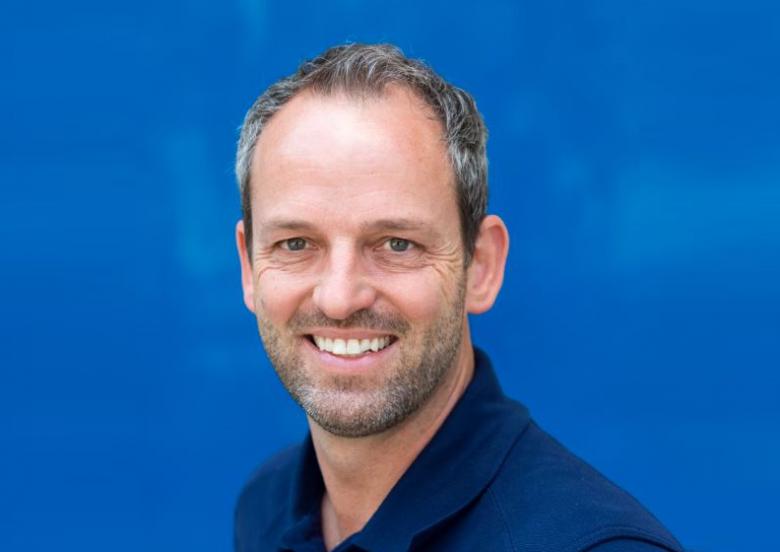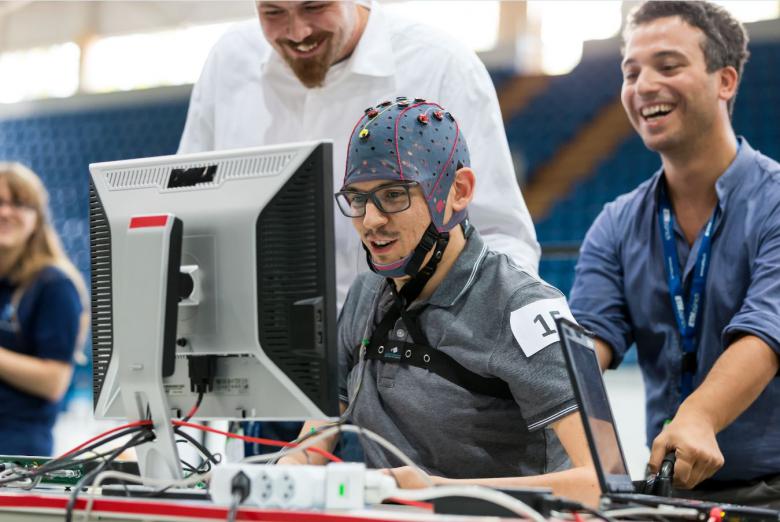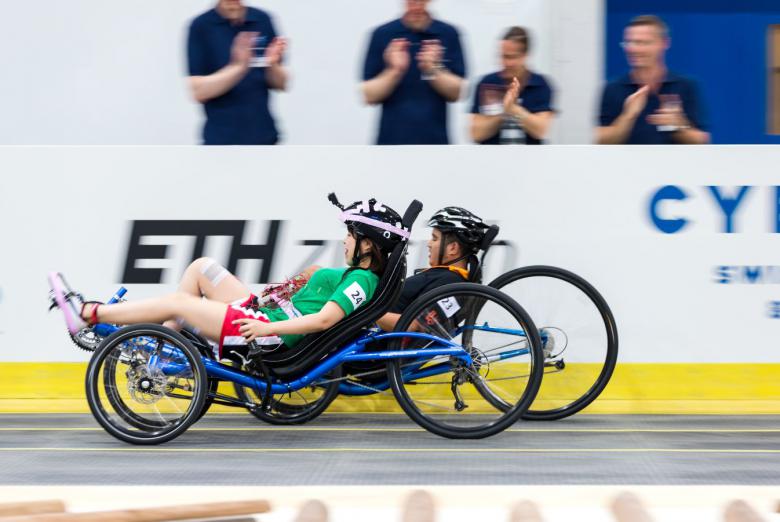Cybathlon: the first ever Olympics for bionic athletes
The Swiss Federal Institute of Technology Zurich (ETHZ) is organising the world's first ever 'cybathlon' in Kloten in October. The scientific competition features 74 disabled athletes from 25 different nationalities, equipped with bionic prostheses, powered exoskeletons and brain-computer interfaces.
Everyone still remembers 4 August 2012. In front of millions of people watching the London Olympic Games on TV, the South African Oscar Pistorius launched himself into his 400m heat on carbon-fibre running blades. Pistorius, who was born with no fibulas, became the first disabled athlete using assistive technology to compete among the able-bodied.
Unprecedented as this was, the case of Pistorius was both fascinating and puzzling: was his sporting prowess the result of his prosthesis or his training? What would happen if bionic prostheses and robotic exoskeletons were to reach such technical sophistication that they could be used for athletic purposes? Fours year on this is no longer merely a hypothesis, but a reality. And it is taking shape in Switzerland.

A world first
On 8 October 2016, Kloten is set to host the Olympic Games for bionic athletes: the cybathlon. This world premiere will see 74 international disabled athletes – kitted out with bionic prostheses and brain-computer interfaces – compete with each other at the specially created events. These modern-day cyborgs from 25 different countries will compete in 59 different teams from all over the world, including seven from Switzerland.
The initiative was launched by Robert Riener, a professor of sensory-motor systems at ETHZ. "One of the goals of the cybathlon is to encourage researchers and developers to work on robotic technologies that can substantially improve daily life for people with disabilities."

He adds: "You can run a lot faster with bionic legs, but you can't sit down with them. Research has to foster technology, but society as a whole must limit the structural barriers that impede people with disabilities in their natural environment."
Getting rid of disabilities
For the 'cybathletes', the purpose of the event is not therefore about physical performance. Rather, it is about accomplishing the daily tasks they are subjected to during the competition's events – with the help of assistive technology. Having trained for months in robotics laboratories the world over, the bionic athletes must now – for example – open a tin with their prosthetic arms. Or hang up photos using string.
Another discipline sees the athletes climbing stairs in wheelchairs. Elsewhere, paralysed competitors will take on a bike race aided by electrical stimulation – a technology that allows them to contract and move their muscles. There are six disciplines in total at the Kloten cybathlon.
This international meet is first and foremost a scientific competition. The athletes have been training for more than two years in their respective robotics laboratories. It is Mr Riener's ambition to see this event live on, by organising an annual cybathlon to develop collaborative projects between researchers, prosthetic engineers and disabled people.
New research projects already under way
In Switzerland, this first cybathlon is combining robotics research from the ETHZ, the Swiss Federal Institute of Technology Lausanne (EPFL), and technical schools in Rapperswil and Bern. The public competition is expected to draw up to 5,000 people, with a scientific symposium being held beforehand on 6 and 7 October. New projects researching robotics are already emerging and contributing to how these technologies perform.
At the technical level first of all, robotics are at the heart of the biomaterials revolution – they connect electronic systems to the human body through prostheses and implants with the aim of repairing or improving physical capacities that are impaired. Like those behind the cybathlon, Swiss research is particularly active in this area.

The other revolution concerns robotic mobility. Bionic prostheses and exoskeletons are inspired by nature, by animals that have perfected the art of crawling or walking. Engineers rival each other in their inventiveness to ensure their technology helps to improve disabilities, pushing humanity's limits and posing new questions – tomorrow, disabled or not, will we all become bionic human beings?
The birth of cyborgs
The scientific community did not wait for Oscar Pistorius's first running event to ask themselves this. Kevin Warwick of the United Kingdom can boast being the first cyborg in the history of humanity. The 62-year-old professor at Reading University's Department of Cybernetics is a world renowned expert in robotics, bioethics and, most recently, artificial intelligence. His work and research in the development of interactions between humans and machines have been carried out in collaboration with prestigious universities (MIT, Harvard, Stanford), robotic laboratories and institutions developing these technologies. It was Professor Warwick who inspired the creation of the EPFL's Center of Micronanotechnology (Cmi). His research involves looking at ways of applying these technologies in the biomedical field. And ultimately to break down the barriers imposed by disabilities. How does he see that happening?
Since the late 1990s, Professor Warwick has played the role of guinea pig for scientific research by implanting in his body electronic components allowing him to interact with computers and robots. The contemporary Frankenstein enhanced his body in this way for the first time in 1998, inserting an RFID chip into the elbow of his left arm. With this chip, Professor Warwick was able to use remote control to open and close the doors of his laboratory. He lived as a cyborg for just nine days. In 2002, the scientist entered brain territory with his project entitled 'The Brain Gate', whereby a neural interface designed by Dr Mark Gasson was implanted in his nervous system.

This groundbreaking experiment lasted three months. The technology enabled him to take remote control of a robotic hand, using any standard wi-fi network to connect to it, from any geographical location. At a conference at the University of Bogota, Professor Warwick demonstrated his powers to the audience, who were able to see the nervous system of the professor displayed on a computer screen. They watched as live from Colombia he took control of the bionic hand back in the UK, in Reading.
The Paralympics set to become a thing of the past
These scientific experiments on the brain usually elicit either fascination or repulsion, but they do pave the way for finding cures for people with dementia or with disabilities and solutions for amputees. In Japan, the Superhuman Sports Academy is developing new sports drawing on new technologies, such as football matches with an augmented reality headset, and exoskeleton races. Indeed, at the Olympic Games to be held in 2020 in Tokyo, the Superhuman Sports Academy intends to include "new technology-based sports that strengthen and extend human capabilities". Ultimately, the distinction between the Paralympics and the Olympics will no longer have any raison d’être.





